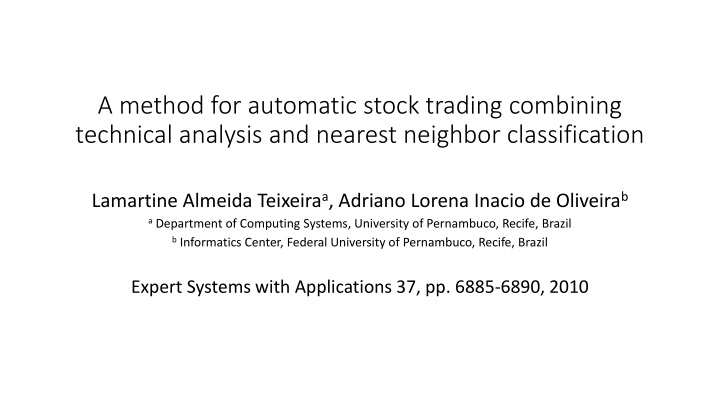
Automatic Stock Trading Method Combining Technical Analysis
Explore a novel method for automatic stock trading that merges technical analysis with nearest neighbor classification, demonstrating higher profitability than a buy-and-hold strategy by incorporating tools like Moving Averages, RSI, Stochastics Oscillator, and Bollinger Bands.
Download Presentation

Please find below an Image/Link to download the presentation.
The content on the website is provided AS IS for your information and personal use only. It may not be sold, licensed, or shared on other websites without obtaining consent from the author. If you encounter any issues during the download, it is possible that the publisher has removed the file from their server.
You are allowed to download the files provided on this website for personal or commercial use, subject to the condition that they are used lawfully. All files are the property of their respective owners.
The content on the website is provided AS IS for your information and personal use only. It may not be sold, licensed, or shared on other websites without obtaining consent from the author.
E N D
Presentation Transcript
A method for automatic stock trading combining technical analysis and nearest neighbor classification Lamartine Almeida Teixeiraa, Adriano Lorena Inacio de Oliveirab aDepartment of Computing Systems, University of Pernambuco, Recife, Brazil bInformatics Center, Federal University of Pernambuco, Recife, Brazil Expert Systems with Applications 37, pp. 6885-6890, 2010
Abstract In this paper we propose and analyze a novel method for automatic stock trading which combines technical analysis and the nearest neighbor classification. Our first and foremost objective is to study the feasibility of the practical use of an intelligent prediction system exclusively based on the history of daily stock closing prices and volumes. To this end we propose a technique that consists of a combination of a nearest neighbor classifier and some well known tools of technical analysis, namely, stop loss, stop gain and RSI filter. For assessing the potential use of the proposed method in practice we compared the results obtained to the results that would be obtained by adopting a buy-and-hold strategy. The key performance measure in this comparison was profitability. The proposed method was shown to generate considerable higher profits than buy-and-hold for most of the companies, with few buy operations generated and, consequently, minimizing the risk of market exposure.
Technical indicator using in this paper Moving averages(MA) Form a smooth curve which makes easier to identify the direction of the trend. t: t X(t): t
Relative strength index (RSI): It compares the magnitude of the recent gains to the magnitude of the recent losses and generates a number that ranges from 0 to 100. (n = 14) RSI 70 RSI 30
Stochastics oscillator (KD): n t (n = 14) ( 3 %k MA) %K>%D 50%: 80%: 20%: K D
Bollinger bands: = + 2 period n = period n SMA = 2 period n (n = 8) : Bollinger : Bollinger
Using K-NN input: 100 1998/4/1~2009/3/9 Sao Paulo Stock Exchange (Bovespa) 15 Xh: Xl: PMA:price MA VMA:volume MA s:short-term = 10 l:long-term = 21
K-NN: The classifier s output is used to start a buy (long) or sell (short) operation. (the minimum number of 100 shares per operation) Trading rule: If the classifier s output for day t is buy, then a long position is performed considering the stock s closing price and all the available cash balance. If the classifier s output is sell and there are any stock available in custody, then all the stocks are sold. Otherwise, no operation is performed if the generated signal is keep. Stop gain: 10% ( ) Stop loss: 3% RSI filter: 70%
Experiment 3 1 R$ 100,000 R$ 5
11/153/151/15 40 4 (7 testing period )
